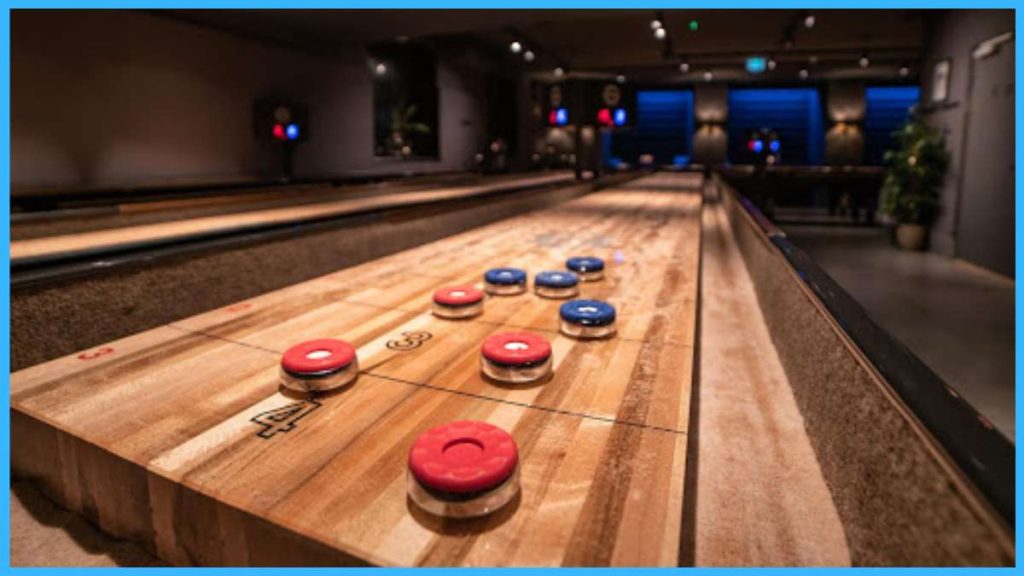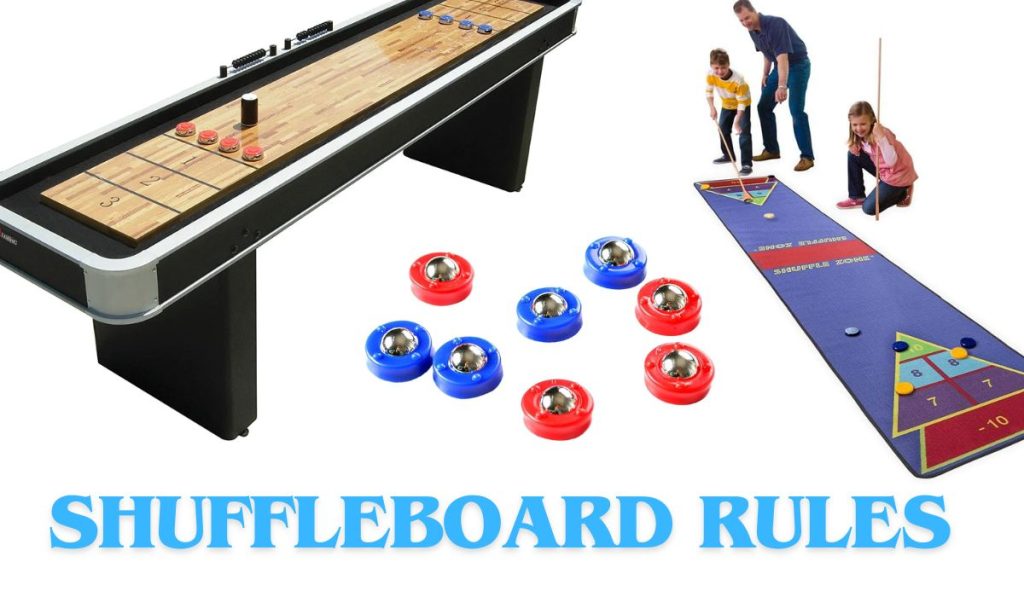Welcome to the competitive world of Shuffleboard, where precision and accuracy are everything! However, there are different versions of the game, each with its own set of rules. In this article, we shall discuss shuffleboard rules, the court version of the game, and its scoring method.
However, for the unversed, the game’s origins can be dated back to the 1500s when it was popular among Europeans as a pastime. Today, the evolved version of the game is played far more seriously on meticulously designed shuffleboard courts. Players use long sticks (cue sticks) to propel disk-like objects to the scoring end of the court. Shuffleboard is an exciting game, but you need to know the rules to play it how it is meant to be. Without further ado, let’s get into the thick of it!
Table of Contents
How To Play Shuffleboard Game?
Shuffleboard was initially played as a leisure sport. Over the years, the game underwent multiple modifications to transform into the game we dearly love today.
According to shuffleboard rules, the players must use cue sticks to propel the pucks (disk-like objects) across the shuffleboard court into the scoring area, where the scoring zones are marked (10-point, 8-point, and 7-point). The puck must land within the designated scoring zones (within the lines), and the player will be awarded the respective points. Players can also employ a variety of winning strategies to win the Shuffleboard game.
Objective
The objective is to score more points than your opponent and win the game. This means propelling the puck to accurately land in the higher-scoring zones more often than your opponent’s. At the end of the Shuffleboard game, the player with the highest score (based on the summation of the scores acquired during the game) wins.

What Are The Basic Rules Of Shuffleboard?
The nature of the game is such that people of all ages and with varying skill levels can enjoy it to its fullest potential. But, to do that, learning what are the rules of Shuffleboard is a must. In this section of the article, we shall go over the details of Shuffleboard’s regulations. Being a multi-faceted game, we shall explain the rules relating to the different aspects of the game below:
General Rules Of Shuffleboard
The general shuffleboard rules are pretty elementary, which makes Shuffleboard a game that is thrilling to people worldwide. Let’s learn more about the general rules of the Shuffleboard game:
- A coin toss is made to decide the player who will go first. In the following matches (if playing a game of multiple matches), the player who won the last game will start.
- Games can be played for 75 points, 50 points, or 100 points (whatever the players determine).
- Every shuffleboard game is played in half rounds, at the end of which the scores are calculated and tallied.
- Shuffleboard rules state that the yellow puck is shot first, meaning the player who wins the toss automatically gets the yellow puck.
- However, no player can shoot two pucks back to back (unless some special conditions are agreed upon before starting the game). A player can shoot one puck at a time, and the other player gets to go next, taking turns alternatively.
- Hook shots are disallowed. That means players must shoot their pucks in one continuous forward-propelling motion.
- If a puck is in motion, the next player must wait until it comes to a halt. Only then can the next player play his shot.
- Further, Shuffleboard rules state that if you play or shoot your opponent’s puck, 10 points will be removed from your score as a penalty.
- The play begins by alternating between the two ends of the shuffleboard court. If the first game starts on one end, the next begins on the other.
- Points are calculated after all eight pucks (4 for each player) have been played/shot. The validity of shots can be verified after each shot, but each match’s score must be calculated at the end.
- In case a puck is removed from the game, then no points are awarded if:
- a) The puck fails to cross the deadline (the line that a puck needs to cross to be valid), or
- b) If the puck tips off the court’s edge.
Singles And Doubles Shuffle board Rules
Conventionally, shuffleboard is played between two players only, but there are rules in place for playing it as a doubles sport. In singles, two players play against each other, while in doubles, four players (two players on each team) are involved.
- In a doubles game, each team needs to elect a player who will represent that team in starting the game from the head of the court.
- Further, each player from a team will take alternate turns in shooting. In other words, one player from one team will shoot first. Then, an elected player from the other team will get their turn to play. After that, the other player from the first team will shoot their shot.
- In case of a draw in doubles, two full rounds will be played (or two half rounds) to decide the winner, per shuffleboard rules.
- In singles, each player gets four sets of pucks to play with. The player who starts the game gets the lighter-colored pucks (mostly yellow).
- If you want, you can play singles as walking singles. In other words, both players stand and play from the same end of the court. Then, after the round, they change the sides and play from the other end.
- For non-walking singles, each player stands on either end of the court.
Shuffleboard Scoring
To win a game of Shuffleboard, you should know what are the rules of shuffleboard scoring and to outscore your opponents. The player with the higher score at the end of the match wins. Mentioned below are the Shuffle board rules and regulations for scoring in the game.
- According to shuffleboard rules, players will shoot their respective pucks alternatively.
- A player needs to shoot their puck into the scoring zone to score. The zone where the puck comes to a stop after shooting (10-point, 8-point, or 7-point), the point equivalent to that zone, is awarded to the player.
- For a score to register and be valid, the puck needs to be entirely inside that zone (for example, if the puck is entirely inside the 7-point zone, the player will only get 7 points).
- If the puck lands on any lines demarcating the scoring zones, no score is added. For example, if the puck stops on the line between the 10-point and 8-point zones, no score is added.
- Points will be counted after each player has played all four pucks.

Blocking
There are strategies that expert players apply to every game to get an upper hand over their opponents, fair and square. Shuffleboard is no different. Blocking is a skillful defensive technique that, if used correctly, can be enormously advantageous. Let’s learn more about this:
- The official Rules of Shuffleboard state that blocking is only valid if your puck crosses the deadline.
- If your puck is stuck on a line (caught in the middle of two scoring zones), then you can line up another puck carefully behind or around it so that if the opponent’s puck hits yours, the puck that is on the line may enter the scoring zone by a ‘chain reaction’ of sorts.
- Alternatively, if the opponent tries to place their puck around the defending puck, there is a chance that their puck will score no points or be removed from the match.
Penalties
The regulations pertaining to penalties in Shuffleboard can be punishing or rewarding (depending on who is penalized). If a shot results in a penalty, scores are deducted depending on the nature of the penalty.
Let’s find out more about this:
- The penalty zone lies beyond the 7-point zone. Per shuffleboard rules, it is also marked with ’10.’
- If a disc lands in the penalty zone (behind the 7-point zone), then the player whose disc lands in that area is penalized, and 10 points are deducted from their score.
- The 10-off rule applies to pucks that directly landed in that zone as well as pucks that were pushed into the zone by another puck (opponent players or their own).
The penalties (in points) as per shuffleboard rules are as follows:
- Ten points off for shooting an opponent’s puck.
- Ten points off if a player’s body touches the baseline or crosses the baseline when shooting.
- Ten points off if a puck touches the sidelines or if the puck touches the side of the triangle when being played.
- Five points off if a puck touches the 10-off area before it is shot or played.

Winning
Playing it right will surely get you many points, but how will you strategize unless you know how to win the game? Well, winning is easy if you know the rules of shuffleboard. They are as follows:
- A shuffleboard game can be played for 75 points, 50 points, or even 100 points.
- The first person (or team) that reaches 75 points wins the game.
- But sometimes, the match goes on for that half-round after a player (or team) reaches 75 points. If the other player (or team) reaches 75 points as well (a tie), then the player/team that received the highest score in that half-round wins.
Equipment & Field
Equipment:
The thing about Shuffleboard is that barely any fancy equipment is needed to play the game. All you need is an opponent, a shuffleboard court, two cue sticks, eight pucks, a great knowledge of shuffleboard rules, and a lot of enthusiasm.
Field:
- The shuffleboard court can vary in dimensions from anywhere between 25ft x 6ft to 23ft x 3ft.
- The shuffleboard court features two triangles on either end of the full court.
- The first scoring zone, which is the smallest, is the 10-point zone.
- Beneath this is the 8-point scoring zone. This zone is split into two by a dividing line that runs down the middle of the entire 8-point zone.
- After that, there is the 7-point scoring zone, which is also divided into two zones by the same line and continues until the bottom line of the 7-point zone.
- Beneath the 7-point scoring zone is the 10-off zone. Per shuffleboard rules, if a player’s puck enters the 10-off zone, 10 points are deducted from his net score.
Strategies & Tips
Now that you have learned the basics of the game, it is time to take the learning to the next level. In this section of the article, we shall be shedding light on some invaluable tips and strategies that will help you become a better shuffleboard player. Let’s dive in:
- Your strategy should be to score early and defend successfully right from the start. For example, you can dedicate two of your pucks to scoring and two to protecting those points and removing points from your opponent’s score.
- Scoring a ten isn’t always better. This is because it’s the first scoring zone on the court, and most opponents will either aim for it or find it easy to knock your puck off it and onto a line.
- When playing a blocked puck (yours or your opponents’), be careful so as not to lose points (even if you cannot gain points). However, you should aim to get your opponent’s puck off the scoring zones and preferably into the 10-off zone (behind the 7-point zone). This will reduce their points and increase your chances of winning.
- Take your time before you make your shot. The first thing you need to do is line up your stick behind the puck you want to shoot so you can see exactly where it is going.
- Try to play down the middle as much as possible. This will allow you to avoid having one or more of your pucks removed from the game.
- Shuffle board rules state that you should try to push the opponent’s puck off the scoring zone or the court. This will remove their puck from the game altogether, leaving you a higher chance of winning.

Did You Know?
- The prominence of Shuffleboard, even in earlier times, can be seen in the game’s mention in William Shakespeare’s plays.
- Claims have been made that state that Christopher Columbus brought the game of Shuffleboard to the New World with him.
- Besides being a competitive game, Shuffleboard is a great game for socializing and making new friends.
- Shuffleboard game originated in Europe and has gained popularity over the years. It is played in countries like Canada, Japan, Australia, and Brazil.
FAQs
Can only two players play Shuffleboard?
Not necessarily. It all depends on what is determined before the game begins. If there are two or more players in each team, then each player can take turns playing.
Is Shuffleboard played indoors or outdoors?
You would be surprised to know that Shuffleboard can be played indoors and outdoors. In fact, there is a table version of Shuffleboard that is also extremely fun to play.
How many points can I play Shuffleboard for?
Depends! According to the official rules of shuffleboard, games can be played for 50, 75, or even 100 points.
Do points cancel out in Shuffleboard game?
No. Points do not cancel out in Shuffleboard (your own). However, points are deducted from their score if you push your opponent’s puck into the penalty zones. Refer to the above for the penalty zones and the points deducted for each, per shuffleboard rules.
How do you score in table shuffleboard?
In table shuffleboard, the scoring zones are marked with 1, 2, and 3 points. Pucks must fully cross a scoring line to count for that zone. Only the team with the furthest puck from the foul line scores, and points are awarded based on the zones the pucks land in.
Do you need exactly 21 in shuffleboard?
Table shuffleboard is typically played to 15 or 21 points, depending on the agreed-upon rules. Some house rules introduce a “must win by two points” condition.
What is a foul in shuffleboard?
A foul in shuffleboard occurs when a puck does not cross the foul line or when a player touches a puck after it has been shot. Additionally, if a puck falls off the table, it is considered out of play.
Although a game that can be called ‘ancient’ to some extent, Shuffleboard can be hailed as one of the greatest games to have ever existed. The rules of the game are simple, making it easy to learn and play. So, if you have your cue stick ready and have learned the shuffleboard rules in detail, it is time to hit the court and show off your knowledge and skills regarding Shuffleboard game!
Read More: Have you heard of Kickball Game? Well, here is another interesting read for you if you want to learn about the Kickball Rules.

